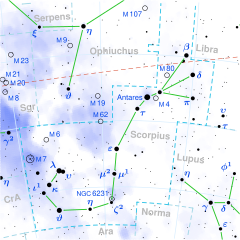Rho Scorpii
| Observation data Epoch J2000 Equinox J2000 | |
|---|---|
| Constellation | Scorpius |
| Right ascension | 15h 56m 53.07624s[1] |
| Declination | −29° 12′ 50.6612″ [1] |
| Apparent magnitude (V) | 3.86[2] |
| Characteristics | |
| Spectral type | B2 IV[3] |
| U−B color index | -0.82[2] |
| B−V color index | -0.20[2] |
| Astrometry | |
| Radial velocity (Rv) | −0.40[4] km/s |
| Proper motion ( | RA: −15.68[1] mas/yr Dec.: −24.88[1] mas/yr |
| Parallax ( | 6.91 ± 0.19 mas[1] |
| Distance | 470 ± 10 ly (145 ± 4 pc) |
| Absolute magnitude (MV) | −1.93[5] |
| Orbit[6] | |
| Period (P) | 4.0033 d |
| Eccentricity (e) | 0.27 |
| Periastron epoch (T) | 2442178.6060 JD |
| Argument of periastron ( (secondary) | 231° |
| Semi-amplitude (K1) (primary) | 16.40 km/s |
| Details | |
| Mass | 7.94±0.55[3] M☉ |
| Radius | 5.0[7] R☉ |
| Luminosity (bolometric) | 3,432[3] L☉ |
| Temperature | 21,150[3] K |
| Rotational velocity (v sin i) | 113[8] km/s |
| Other designations | |
| Database references | |
| SIMBAD | data |
Rho Scorpii (
It has two components, designated Rho Scorpii A and B. Rho Scorpii A is itself a single-lined spectroscopic binary whose components are designated Rho Scorpii Aa (formally named Iklil /ˈɪklɪl/, traditionally the name for several neighboring stars)[12] and Ab.
Nomenclature
[edit]Rho Scorpii was likely part of the Arabic lunar mansion of Iklil (الإكليل al-ʼiklīl) "the crown (of the forehead)"), along with Beta, Delta, Pi and possibly Nu Scorpii.
The corresponding asterism in Chinese astronomy,
In 2016, the I
Properties
[edit]Rho Scorpii A displays the spectrum of blue-white B-type subgiant with a stellar classification of B2 IV.[3] It has an estimated mass nearly 8 times that of the Sun's and shines with 3,432 times the Sun's luminosity.[3] The two constituent stars orbit each other with a period of 4 days and an eccentricity of 0.27.[6]
Rho Scorpii B is a magnitude 12.80 visual companion that lies at an angular separation of 38.40 arcseconds along a position angle of 95°, as of the year 2000.[18]
References
[edit]- ^ a b c d e f van Leeuwen, F. (November 2007), "Validation of the new Hipparcos reduction", Astronomy and Astrophysics, 474 (2): 653–664, arXiv:0708.1752, Bibcode:2007A&A...474..653V, doi:10.1051/0004-6361:20078357, S2CID 18759600.
- ^ a b c Ducati, J. R. (2002), "VizieR Online Data Catalog: Catalogue of Stellar Photometry in Johnson's 11-color system", CDS/ADC Collection of Electronic Catalogues, 2237, Bibcode:2002yCat.2237....0D.
- ^ a b c d e f Hohle, M. M.; et al. (April 2010), "Masses and luminosities of O- and B-type stars and red supergiants", Astronomische Nachrichten, 331 (4): 349, arXiv:1003.2335, Bibcode:2010AN....331..349H, doi:10.1002/asna.200911355, S2CID 111387483.
- ^ Evans, D. S. (June 20–24, 1966), "The Revision of the General Catalogue of Radial Velocities", in Batten, Alan Henry; Heard, John Frederick (eds.), Determination of Radial Velocities and their Applications, Proceedings from I
AU Symposium no. 30, vol. 30, University of Toronto: International Astronomical Union, p. 57, Bibcode:1967IAUS...30...57E. - ^ Anderson, E.; Francis, Ch. (2012), "XHIP: An extended hipparcos compilation", Astronomy Letters, 38 (5): 331, arXiv:1108.4971, Bibcode:2012AstL...38..331A, doi:10.1134/S1063773712050015, S2CID 119257644.
- ^ a b Pourbaix, D.; et al. (September 2004), "SB9: The ninth catalogue of spectroscopic binary orbits", Astronomy and Astrophysics, 424: 727–732, arXiv:astro-ph/0406573, Bibcode:2004A&A...424..727P, doi:10.1051/0004-6361:20041213, S2CID 119387088.
- ^ Pasinetti Fracassini, L. E.; et al. (February 2001), "Catalogue of Apparent Diameters and Absolute Radii of Stars (CADARS) - Third edition - Comments and statistics", Astronomy and Astrophysics, 367 (2): 521–524, arXiv:astro-ph/0012289, Bibcode:2001A&A...367..521P, doi:10.1051/0004-6361:20000451, S2CID 425754.
- ^ Simón-Díaz, S.; Herrero, A. (2014), "The IACOB project: I. Rotational velocities in northern Galactic O- and early B-type stars revisited. The impact of other sources of line-broadening", Astronomy & Astrophysics, 562: A135, arXiv:1311.3360, Bibcode:2014A&A...562A.135S, doi:10.1051/0004-6361/201322758, S2CID 119278062.
- ^ "rho Sco". SIMBAD. Centre de données astronomiques de Strasbourg. Retrieved 2016-09-22.
{{cite web}}: CS1 maint: postscript (link) - ^ Shatsky, N.; Tokovinin, A. (January 2002), "The mass ratio distribution of B-type visual binaries in the Sco OB2 association", Astronomy and Astrophysics, 382: 92–103, arXiv:astro-ph/0109456, Bibcode:2002A&A...382...92S, doi:10.1051/0004-6361:20011542, S2CID 16697655.
- ^ Grellmann, R.; et al. (June 2015), "New constraints on the multiplicity of massive young stars in Upper Scorpius", Astronomy & Astrophysics, 578: 11, Bibcode:2015A&A...578A..84G, doi:10.1051/0004-6361/201219577, A84.
- ^ a b "Naming Stars". IAU.org. Retrieved 16 December 2017.
- ^ Hessman, F. V.; Dhillon, V. S.; Winget, D. E.; Schreiber, M. R.; Horne, K.; Marsh, T. R.; Guenther, E.; Schwope, A.; Heber, U. (2010). "On the naming convention used for multiple star systems and extrasolar planets". arXiv:1012.0707 [astro-ph.SR].
- ^ (in Chinese)
中國 星座 神話 , written by陳 久金 . Published by台灣 書房 出版 有限 公司 , 2005, ISBN 978-986-7332-25-7. - ^ (in Chinese)
香港 太 空 館 -研究 資源 -亮 星 中 英 對照 表 Archived 2008-10-25 at the Wayback Machine, Hong Kong Space Museum. Accessed on line November 23, 2010. - ^ "I
AU Working Group on Star Names (WGSN)". Retrieved 22 May 2016. - ^ "WG Triennial Report (2015-2018) - Star Names" (PDF). p. 5. Retrieved 2018-07-14.
- ^ Mason, B. D.; et al. (2014), "The Washington Visual Double Star Catalog", The Astronomical Journal, 122 (6): 3466, Bibcode:2001AJ....122.3466M, doi:10.1086/323920
External links
[edit]- Kaler, James B. (June 20, 2008), "Rho Scorpii", Stars, University of Illinois, retrieved 2016-09-23.

